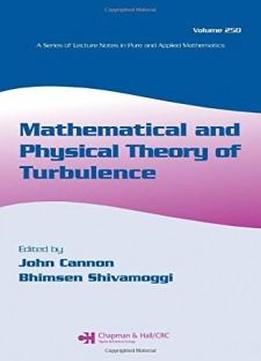
Mathematical And Physical Theory Of Turbulence, Volume 250 (lecture Notes In Pure And Applied Mathematics)
by John Cannon /
2006 / English / PDF
3.1 MB Download
Although the current dynamical system approach offers several
important insights into the turbulence problem, issues still remain
that present challenges to conventional methodologies and concepts.
These challenges call for the advancement and application of new
physical concepts, mathematical modeling, and analysis techniques.
Bringing together experts from physics, applied mathematics, and
engineering,
Although the current dynamical system approach offers several
important insights into the turbulence problem, issues still remain
that present challenges to conventional methodologies and concepts.
These challenges call for the advancement and application of new
physical concepts, mathematical modeling, and analysis techniques.
Bringing together experts from physics, applied mathematics, and
engineering,Mathematical and Physical Theory of Turbulence
Mathematical and Physical Theory of Turbulence
discusses recent progress and some of the major unresolved issues
in two- and three-dimensional turbulence as well as scalar
compressible turbulence.
discusses recent progress and some of the major unresolved issues
in two- and three-dimensional turbulence as well as scalar
compressible turbulence.
Containing introductory overviews as well as more specialized
sections, this book examines a variety of turbulence-related
topics. The authors concentrate on theory, experiments,
computational, and mathematical aspects of Navier–Stokes
turbulence; geophysical flows; modeling; laboratory experiments;
and compressible/magnetohydrodynamic effects. The topics
discussed in these areas include finite-time singularities and
inviscid dissipation energy; validity of the idealized model
incorporating local isotropy, homogeneity, and universality of
small scales of high Reynolds numbers, Lagrangian statistics, and
measurements; and subrigid-scale modeling and hybrid methods
involving a mix of Reynolds-averaged Navier–Stokes (RANS),
large-eddy simulations (LES), and direct numerical simulations
(DNS).
Containing introductory overviews as well as more specialized
sections, this book examines a variety of turbulence-related
topics. The authors concentrate on theory, experiments,
computational, and mathematical aspects of Navier–Stokes
turbulence; geophysical flows; modeling; laboratory experiments;
and compressible/magnetohydrodynamic effects. The topics
discussed in these areas include finite-time singularities and
inviscid dissipation energy; validity of the idealized model
incorporating local isotropy, homogeneity, and universality of
small scales of high Reynolds numbers, Lagrangian statistics, and
measurements; and subrigid-scale modeling and hybrid methods
involving a mix of Reynolds-averaged Navier–Stokes (RANS),
large-eddy simulations (LES), and direct numerical simulations
(DNS).
By sharing their expertise and recent research results, the
authoritative contributors in
By sharing their expertise and recent research results, the
authoritative contributors inMathematical and Physical Theory
of Turbulence
Mathematical and Physical Theory
of Turbulence promote further advances in the field,
benefiting applied mathematicians, physicists, and engineers
involved in understanding the complex issues of the turbulence
problem.
promote further advances in the field,
benefiting applied mathematicians, physicists, and engineers
involved in understanding the complex issues of the turbulence
problem.











